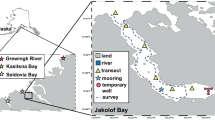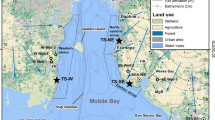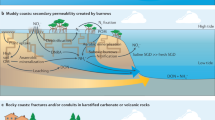Abstract
Submarine groundwater discharge represents a major but poorly constrained component of coastal marine chemical budgets. In the current study, the geochemical behavior of 224Ra, inorganic nitrogen species, and Fe in shallow coastal groundwater was characterized to improve estimates of chemical flux via submarine groundwater discharge (SGD) at a site in the York River estuary, VA (USA). Directly measured SGD rates varied between 3.9 ± 1.2 cm day−1 offshore, and 8.9 ± 2.6 cm day−1 close to shore. A clear inverse relationship was observed between SGD and tidal height, reflecting the hydraulic gradient between groundwater and surface water. Discharge rates varied spatially in conjunction with the subterranean estuary location, and there was a strong inverse correlation between seepage rates and seepage salinity. Dissolved 224Ra activity in the mixing zone reached levels up to 6 dpm L−1 and co-varied with salinity in the groundwater but not in the surface water or seepage water. Instead, a consistent sigmoidal trend of Ra with pH was observed, which matched previous laboratory experiment results. Dissolved NH4 + reached concentrations up to 120 μM in the groundwater and appeared to mix conservatively with respect to salinity in the subterranean estuary. In contrast, NOx (NO2 − + NO3 −) was low in both fresh groundwater and surface water and showed non-conservative enrichment (up to 23 μM) within the subterranean estuary. Dissolved Fe also showed non-conservative excess in the subterranean estuary, reaching concentrations up to 50 μM. SGD-derived chemical fluxes were estimated using several different commonly used approaches: average groundwater concentrations, pore water constituent-salinity trends coupled with directly collected seepage salinity, constituent concentrations in directly collected seepage, and concentrations in shallowest groundwater samples. Different flux estimates were compared with a “variable endmember” approach based on the observed geochemical distribution and inferred behavior.






Similar content being viewed by others
References
Bartlett, R., R.J.G. Mortimer, and K.M. Morris. 2008. Anoxic nitrification: Evidence from Humber Estuary sediments (UK). Chemical Geology 250: 29–39.
Beck, A.J., and M.A. Cochran. 2013. Controls on solid-solution partitioning of radium in saturated marine sands. Marine Chemistry 156: 38–48.
Beck, A.J., and J.P. Rapaglia. 2010. Ra-Th disequilibrium and porewater residence times in permeable coastal sediments. 3rd Ra-Rn Conference, Jerusalem, Israel.
Beck, A.J., Y. Tsukamoto, A. Tovar-Sanchez, M. Huerta-Diaz, H.J. Bokuniewicz, and S.A. Sañudo-Wilhelmy. 2007a. Importance of geochemical transformations in determining submarine groundwater discharge-derived trace metal and nutrient fluxes. Applied Geochemistry 22: 477–490.
Beck, A.J., J.P. Rapaglia, J.K. Cochran, and H.J. Bokuniewicz. 2007b. Radium mass-balance in Jamaica Bay, NY: Evidence for a substantial flux of submarine groundwater. Marine Chemistry 106: 419–441.
Beck, A.J., J.K. Cochran, and S.A. Sañudo-Wilhelmy. 2009. Temporal trends of dissolved trace metals in Jamaica Bay, NY: Importance of wastewater input and submarine groundwater discharge. Estuaries and Coasts 32: 535–550.
Beck, A.J., J.K. Cochran, and S.A. Sañudo-Wilhelmy. 2010. The distribution and speciation of dissolved trace metals in a shallow subterranean estuary. Marine Chemistry 121: 145–156.
Beck, A.J., M.A. Charette, J.K. Cochran, M.E. Gonneea, and B. Peucker-Ehrenbrink. 2013. Dissolved strontium in the subterranean estuary- Implications for the marine strontium isotope budget. Geochimica et Cosmochimica Acta 117: 33–52.
Bone, S.E., M.A. Charette, C.H. Lamborg, and M.E. Gonneea. 2007. Has submarine groundwater discharge been overlooked as a source of mercury to coastal waters? Environmental Science and Technology 41: 3090–3095.
Burnett, W.C., H.J. Bokuniewicz, M. Huettel, W.S. Moore, and M. Taniguchi. 2003. Groundwater and pore water inputs to the coastal zone. Biogeochemistry 66: 3–33.
Burnett, W.C., P.K. Aggarwal, H. Bokuniewicz, J.E. Cable, M.A. Charette, E. Kontar, S. Krupa, K.M. Kulkarni, A. Loveless, W.S. Moore, J.A. Oberdorfer, J. Oliveira, N. Ozyurt, P. Povinec, A.M.G. Privitera, R. Rajar, R.T. Ramessur, J. Scholten, T. Stieglitz, M. Taniguchi, and J.V. Turner. 2006. Quantifying Submarine Groundwater Discharge in the Coastal Zone via Multiple Methods. Science of the Total Environment 367(2-3): 498–543.
Cai, W.J., and Y. Wang. 1998. The chemistry, fluxes, and sources of carbon dioxide in the estuarine waters of the Satilla and Altamaha Rivers, Georgia. Limnology and Oceanography 43: 657–668.
Canfield, D.E., and B. Thamdrup. 2009. Towards a consistent classification scheme for geochemical environments, or, why we wish the term ‘suboxic’ would go away. Geobiology 7(4): 385–392.
Charette, M.A., and M.C. Allen. 2006. Precision Ground Water Sampling in Coastal Aquifers Using a Direct‐Push, Shielded‐Screen Well‐Point System. Groundwater Monitoring & Remediation 26(2): 87–93.
Charette, M.A., and E.R. Sholkovitz. 2002. Oxidative precipitation of groundwater derived ferrous iron in the subterranean estuary of a coastal bay. Geophysical Research Letters 29(10). doi: 10.1029/2001GL014512.
Charette, M.A., and E.R. Sholkovitz. 2006. Trace element cycling in a subterranean estuary: Part 2. Geochemistry of the pore water. Geochimica et Cosmochimica Acta 70(4): 811–826.
Clement, J.-C., J. Shrestha, J.G. Ehrenfeld, and P.R. Jaffe. 2005. Ammonium oxidation coupled to dissimilatory reduction of iron under anaerobic conditions in wetland soils. Soil Biology & Biochemistry 37: 2323–2328.
Crotwell, A.M., and W.S. Moore. 2003. Nutrient and radium fluxes from submarine groundwater discharge to Port Royal Sound, South Carolina. Aquatic Geochemistry 9(3): 191–208.
Dulaiova, H., M.E. Gonneea, P.B. Henderson, and M.A. Charette. 2008. Geochemical and physical sources of radon variation in a subterranean estuary — Implications for groundwater radon activities in submarine groundwater discharge studies. Marine Chemistry 110: 120–127.
Gonneea, M.E., P.J. Morris, H. Dulaiova, and M.A. Charette. 2008. New perspectives on radium behavior within a subterranean estuary. Marine Chemistry 109: 250–267.
Gonneea, M.E., A.E. Mulligan, and M.A. Charette. 2013a. Climate-driven sea level anomalies modulate coastal groundwater dynamics and discharge. Geophysical Research Letters 40: 1–6. doi:10.1002/grl.50192.
Gonneea, M.E., A.E. Mulligan, and M.A. Charette. 2013b. Seasonal cycles in radium and barium within a subterranean estuary: Implications for groundwater derived chemical fluxes to surface waters. Geochimica et Cosmochimica Acta 119: 164–177.
Grasshoff, K., Kremling, K., and Ehrhardt, M. (Eds.) 1999. Methods of seawater analysis. John Wiley & Sons.
Hays, R.L., and W.J. Ullman. 2007. Dissolved Nutrient Fluxes through a Sandy Estuarine Beachface (Cape Henlopen, Delaware, U.S.A.): Contributions from Fresh Groundwater Discharge, Seawater Recycling, and Diagenesis. Estuaries and Coasts 30(4): 710–724.
Hopwood, M.J., P.J. Statham, and A. Milani. 2014. Dissolved Fe (II) in a river-estuary system rich in dissolved organic matter. Estuarine, Coastal and Shelf Science 151: 1–9.
Knee, K.L., and A. Paytan. 2011. Submarine Groundwater Discharge: A Source of Nutrients, Metals, and Pollutants to the Coastal Ocean. In Treatise on Estuarine and Coastal Science, eds. Wolanski E and McLusky DS 4:205–233.
Kroeger, K.D., and M.A. Charette. 2008. Nitrogen biogeochemistry of submarine groundwater discharge. Limnology and Oceanography 53(3): 1025–1039.
Lee, D.R. 1977. A device for measuring seepage flux in lakes and estuaries. Limnology and Oceanography 22(1): 140–147.
Luek, J.L. 2013. Submarine groundwater discharge to the York River Estuary: Quantifying ground water flux and potential for biogeochemical cycling. M.S. thesis. Virginia Institute of Marine Science. 121 pp.
Michael, H.A., J.S. Lubetsky, and C.F. Harvey. 2003. Characterizing submarine groundwater discharge: A seepage meter study in Waquoit Bay, Massachusetts. Geophysical Research Letters 30(6): 1297.
Michael, H.A., A.E. Mulligan, and C.F. Harvey. 2005. Seasonal oscillations in water exchange between aquifers and the coastal ocean. Nature 436: 1145–1148.
Moore, W.S. 1999. The subterranean estuary: a reaction zone of ground water and sea water. Marine Chemistry 65(1-2): 111–125.
Moore, W.S. 2010. The Effect of Submarine Groundwater Discharge on the Ocean. Annual Review of Marine Science 2: 345–374.
Moore, W.S., and R. Arnold. 1996. Measurement of Ra-223 and Ra-224 in coastal waters using a delayed coincidence counter. Journal of Geophysical Research, Oceans 101(C1): 1321–1329.
Moore, W.S., and D.F. Reid. 1973. Extraction of Radium from Natural Waters Using Manganese-Impregnated Acrylic Fibers. Journal of Geophysical Research 78: 8880–8886.
Moore, D.G., and M.R. Scott. 1986. Behavior of 226Ra in the Mississippi River Mixing Zone. Journal of Geophysical Research 91(C12): 14317–14329.
Moore, W.S., J.L. Sarmiento, and R.M. Key. 2008. Submarine groundwater discharge revealed by 228Ra distribution in the upper Atlantic Ocean. Nature Geoscience 1: 309–311.
Mortimer, R.J.G., S.J. Harris, M.D. Krom, T.E. Freitag, J.I. Prosser, J. Barnes, P. Anschutz, P.J. Hayes, and I.M. Davies. 2004. Anoxic nitrification in marine sediments. Marine Ecology Progress Series 276: 37–51.
Rapaglia, J. 2005. Submarine Groundwater Discharge into Venice Lagoon, Italy. Estuaries 28(5): 705–713.
Reay, W.G., and G.M. Simmons. 1992. Groundwater discharge in coastal systems: Implications for Chesapeake Bay. In “Perspectives on Chesapeake Bay, 1992: Advances in Estuarine Sciences, 17-44.
Reay, W.G., D.L. Gallagher, and G.M. Simmons. 1992. Groundwater Discharge and Its Impact on Surface Water Quality in a Chesapeake Bay Inlet. Water Resources Bulletin 28(6): 1121–1134.
Robinson, M., D. Gallagher, and W. Reay. 1998. Field observations of tidal and seasonal variations in ground water discharge to tidal estuarine surface water. Groundwater Monitoring & Remediation 18(1): 83–92.
Roy, M., J.B. Martin, J. Cherrier, J.E. Cable, and C.G. Smith. 2010. Influence of sea level rise on iron diagenesis in an east Florida subterranean estuary. Geochimica et Cosmochimica Acta 74(19): 5560–5573.
Roy, M., J.B. Martin, C.G. Smith, and J.E. Cable. 2011. Reactive-transport modeling of iron diagenesis and associated organic carbon remineralization in a Florida (USA) subterranean estuary. Earth and Planetary Science Letters 304(1): 191–201.
Russoniello, C.J., C. Fernandez, J.F. Bratton, J.F. Banaszak, D.E. Krantz, A.S. Andres, L.F. Konikow, and H.A. Michael. 2013. Geologic effects on groundwater salinity and discharge into an estuary. Journal of Hydrology 498: 1–12.
Santos, I.R., W.C. Burnett, T. Dittmar, I.G.N.A. Suryaputra, and J. Chanton. 2009. Tidal pumping drives nutrient and dissolved organic matter dynamics in a Gulf of Mexico subterranean estuary. Geochimica et Cosmochimica Acta 73: 1325–1339.
Santos, I.R., B.D. Eyre, and M. Huettel. 2012. Driving forces of porewater and groundwater flow in permeable coastal sediments: A review. Estuarine, Coastal and Shelf Science 98: 1–15.
Slomp, C.P., and P. Van Cappellen. 2004. Nutrient inputs to the coastal ocean through submarine groundwater discharge: Controls and potential impact. Journal of Hydrology 295: 64–86.
Spiteri, C., P. Regnier, C.P. Slomp, and M.A. Charette. 2006. pH-Dependent iron oxide precipitation in a subterranean estuary. Journal of Geochemical Exploration 88: 399–403.
Stieglitz, T., M. Taniguchi, and S. Neylon. 2008. Spatial variability of submarine groundwater discharge, Ubatuba, Brazil. Estuarine, Coastal and Shelf Science 76(3): 493–500.
Stookey, L.L. 1970. Ferrozine-A New Spectrophotometric Reagent for Iron. Analytical Chemistry 42(7): 779–781.
Sun, Y., and T. Torgersen. 1998. The effects of water content and Mn-fiber surface conditions on 224Ra measurement by 220Rn emanation. Marine Chemistry 62: 299–306.
Taniguchi, M. 2002. Tidal effects on submarine groundwater discharge into the ocean. Geophysical Research Letters 29(12). doi:10.1029/2002GL014987.
Viollier, E., P.W. Inglett, K. Hunter, A.N. Roychoudhury, and P. Van Cappellen. 2000. The ferrozine method revisited: Fe(II)/Fe(III) determination in natural waters. Applied Geochemistry 15: 785–790.
Windom, H.L., W.S. Moore, L.F.H. Niencheski, and R.A. Jahnke. 2006. Submarine Groundwater Discharge: a Large, Previously Unrecognized Source of Dissolved Iron to the South Atlantic Ocean. Marine Chemistry 102: 252–266.
Winter, T.C., J.W. LaBaugh, and D.O. Rosenberry. 1988. The design and use of a hydraulic potentiomanometer for direct measurement of differences in hydraulic head between groundwater and surface water. Limnology and Oceanography 33(5): 1209–1214.
Zektser, I.S., L.G. Everett, and R.G. Dzhamalov. 2006. Submarine Groundwater. CRC Press, 466 pp
Acknowledgments
Funding from the Research Experience for Undergraduates Summer Intern Program at the Virginia Institute of Marine Science is gratefully acknowledged: grant to Drs. Linda C. Schaffner and Rochelle D. Seitz, NSF OCE 0552612. J. Luek was supported by NSF grant DGE 0840804 to Drs. Kam Tang and Iris Anderson. This is contribution number 3460 from the Virginia Institute of Marine Science.
Author information
Authors and Affiliations
Corresponding author
Additional information
Communicated by Isaac Santos
Rights and permissions
About this article
Cite this article
Beck, A.J., Kellum, A.A., Luek, J.L. et al. Chemical Flux Associated with Spatially and Temporally Variable Submarine Groundwater Discharge, and Chemical Modification in the Subterranean Estuary at Gloucester Point, VA (USA). Estuaries and Coasts 39, 1–12 (2016). https://doi.org/10.1007/s12237-015-9972-0
Received:
Revised:
Accepted:
Published:
Issue Date:
DOI: https://doi.org/10.1007/s12237-015-9972-0




